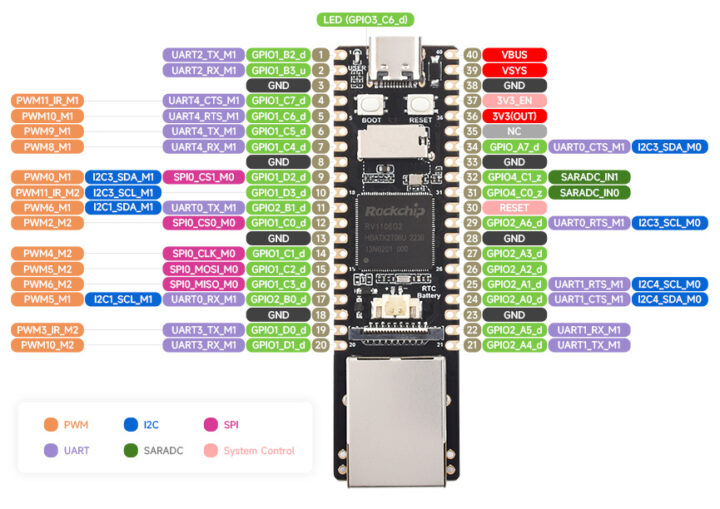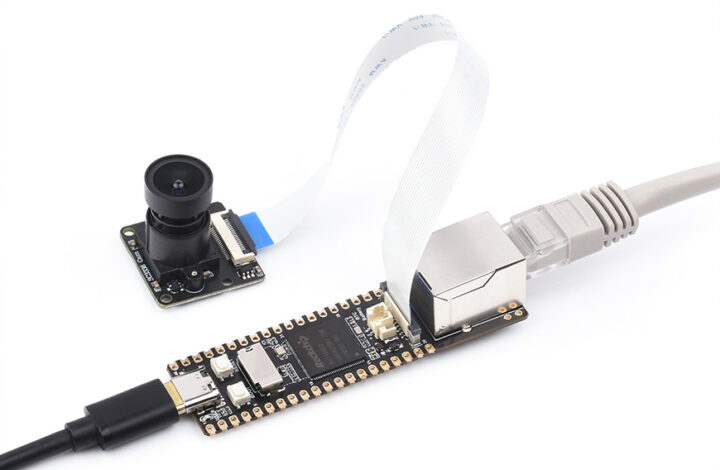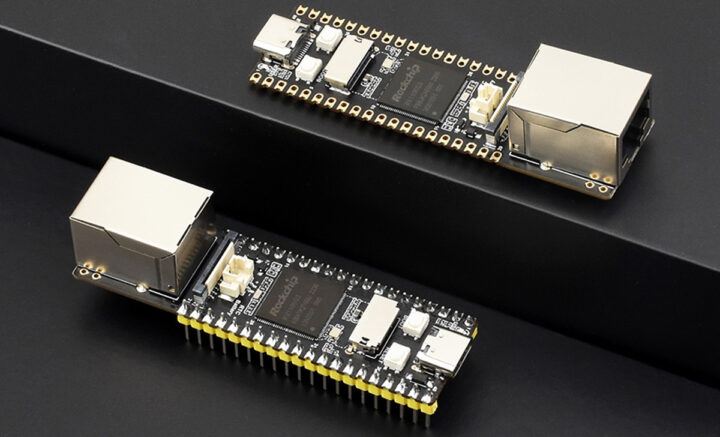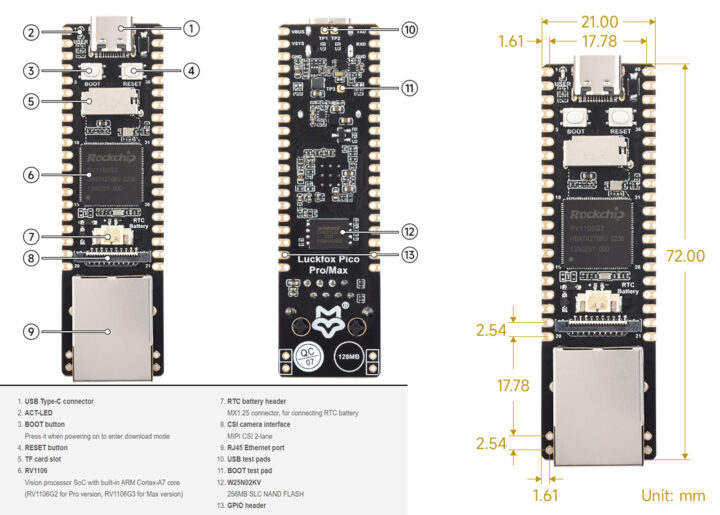The LuckFox LuckFox Pico Pro and Pico Max are two new Rockchip RV1106-powered development boards that offer a Linux-based development platform for IoT applications. The boards feature 10/100M Ethernet, up to 256MB DDR2 memory, and a 0.5TOPS NPU for AI tasks. With support for Buildroot and Ubuntu 22.04, this board can be used for smart homes, remote monitoring, and other AI-enhanced projects.
Last year, we covered the LuckFox Core3566, a Raspberry Pi Compute Module 4 alternative, and the LuckFox Pico with its RV1103 SoC which has a similar form factor and similar features to these new modules. But the new modules are built around the RV1106 SoC which features an Arm Cortex-A7 processor (up to 1.2GHz), a RISC-V co-processor, a 0.5 TOPS NPU for AI tasks, and a 4M @ 30fps ISP for high-quality image processing.
LuckFox Pico Pro and Pico Max Specifications
- SoC – Rockchip RV1106G2
- CPU – Arm Cortex A7 @ 1.2GHz with an integrated RISC-V co-processor.
- NPU– 0.5 TOPS, supports INT4/INT8/INT16, TensorFlow/MXNet/PyTorch/Caffe/Onnx NN
- ISP – 5MP high-performance, HDR, WDR, 3DNR, 2DNR, sharpening, defogging, fisheye and gamma correction, feature detection
- VPU – 3072×1728 (5M) @ 30fps H.265/H.264 encoding, 16M @ 60FPS JPEG snapshot
- System Memory
- LuckFox Pico Pro – 128MB DDR2
- LuckFox Pico Max – 256MB DDR2
- Storage – 256MB SPI NAND flash, microSD card slot
- Connectivity – 10/100M Ethernet RJ45 port
- Camera Interface – MIPI CSI 2-lane support for camera modules.
- Default camera specifications
- Type – Color Camera
- Image Sensor– SC3336
- CMOS Size– 1/2.8″
- Resolution– 3 MP (2304×1296)
- Aperture – F2.0
- Field of View – 98.3°
- Focal Length – 3.95mm
- Distortion – < 33%
- Max Frame Rate – 2304×1296 @ 30fps
- Focus Mode – Manual focus
- USB – USB 2.0 Host/Device Type-C port
- GPIO – 2x 20-pin headers with 26x GPIO pins
- Misc – ACT-LED; BOOT and RESET buttons
- Power Supply – 5V via USB-C port
- Dimensions – 72 x 21 mm
LuckFox provides two versions of their device: the Pico Pro, equipped with 128MB DDR2 memory, and the Pico Max, which comes with 256MB of memory. Both models feature 256MB of SPI NAND flash for storage.

The board offers various interfaces such as MIPI CSI, up to 26 GPIOs, UART, SPI, I2C, and USB. It also includes a 10/100M Ethernet controller with MAC PHY, a MicroSD card slot, a USB Type-C connector, and a 2-lane MIPI CSI camera interface.
The company says that the LuckFox Pico Pro and Pico Max module supports the SC3336 3MP Camera, featuring a SmartSens SC3336 sensor. This 3M MIPI CSI module is said to deliver “superior low-light capabilities, thanks to its high sensitivity and excellent signal-to-noise ratio”. We have also seen this camera used in the Firefly CT36L AI Smart Camera which we wrote about just last month.
In terms of software, LuckFox Pico Pro and Pico Max support Buildroot and Ubuntu 22.04 (server), and you’ll find the instructions to get started on the Wiki.
The Luckfox Pico Pro and Pico Max can be purchased on Aliexpress starting at $12.71 and on Amazon for $22.90 (Pico Max only) The SC3336 3MP camera module can be purchased separately on Aliexpress or Amazon for about $10 and up.
Debashis Das is a technical content writer and embedded engineer with over five years of experience in the industry. With expertise in Embedded C, PCB Design, and SEO optimization, he effectively blends difficult technical topics with clear communication
Support CNX Software! Donate via cryptocurrencies, become a Patron on Patreon, or purchase goods on Amazon or Aliexpress






